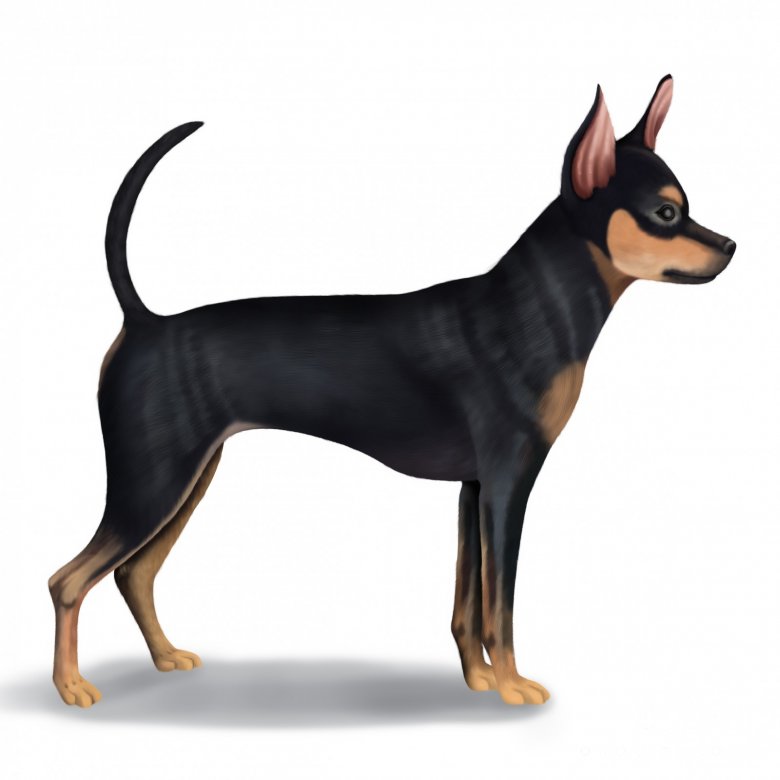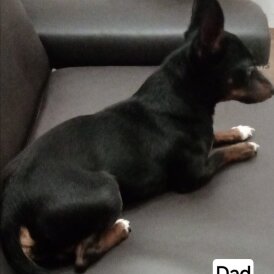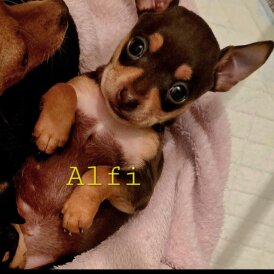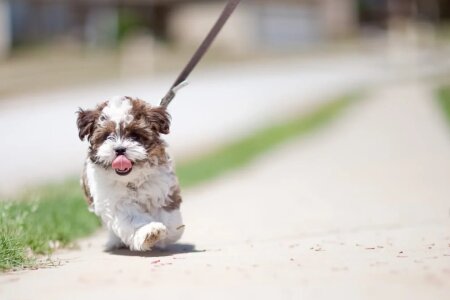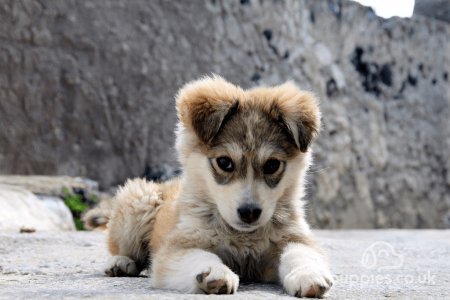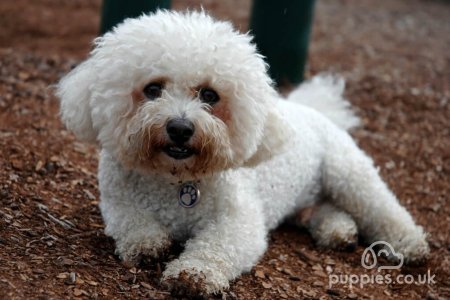Russian Toy Terrier (Russkiy Toy, Moscovian Miniature Terrier, Moscow Toy Terrier)
Overview
The Russian Toy Terrier is a tiny dog that loves to be the centre of attention. This is a dog breed that thrives on being with their human family and is extremely popular in Russia. The Russian Toy Terrier is a fun-loving, energetic character that likes to be busy. After they’ve had their exercise they love to settle down on the sofa with their owner. While small in size, the Russian Toy Terrier is an alert dog that is known for being territorial so are quick to let owners know when there are strangers around. Russian Toy Terriers are petite dogs with long legs and small heads.
Physical Appearance
Tiny in size with lively personalities, the Russian Toy Terrier doesn’t realise how small they are. The Russian Toy Terrier has long legs and an overall elegant look about them. They have long necks, deep chests and a strong, straight back that give them a square appearance. The Russian Toy Terrier’s head is small compared to their body, they have a short muzzle and large, round eyes that are set wide. One of the key distinctive features of a Russian Toy Terrier is their large ears that are held upright and set high. Their tail is medium-length and is held high. This breed is fast-paced and has an effortless stride.
The Russian Toy Terrier can have smooth or long coats. The smooth coat is short and shiny while the long coat can be wavy or straight and has a lot of feathering on the ears, tail and legs. The long-coated Russian Toy Terrier requires more maintenance than the smooth-coated. Each coat type comes in a range of colours including black, red, tan and blue colours.
How big do Russian Toy Terrier dogs get?
Character Traits
The Russian Toy Terrier is a great family dog that is eager to please and loves to learn new things. As Russian Toy Terriers are undeniably cute it is easy to spoil them but this can lead to bad habits and unwanted behaviours. These tiny dogs love to be around their family, they are pretty low maintenance and are more than happy to lie on the sofa with you after they’ve been for a short walk or had some interactive playtime to wear them out. Russian Toy Terriers are territorial and will guard their family and home fearlessly, they are always keeping guard and will bark at strangers.
Are Russian Toy Terrier dogs intelligent? Yes (3/5).
Are Russian Toy Terrier dogs affectionate? Yes.
Do Russian Toy Terrier dogs have high or low energy levels? Low energy levels (2/5).
Are Russian Toy Terrier dogs loyal? Yes.
Are Russian Toy Terrier dogs playful? Yes.
Are Russian Toy Terrier dogs aggressive? No, they prefer to bark at things they don’t like.
Are Russian Toy Terrier dogs easy to train? Relatively easy (3/5).
Are Russian Toy Terrier dogs good guard dogs? They are great watchdogs as they are territorial, alert and will bark at strangers.
Ability to Socialise
A Russian Toy Terrier is a social dog but prefers to be with their human family rather than around other animals. As a terrier breed, they have a high prey drive that means they will chase any smaller animals they encounter. This means they are not a good choice for homes with cats or other pets. Russian Toy Terriers will generally get along with other dogs and are great with kids. When around strangers, the Russian Toy Terrier will be wary and will bark but will soon settle down if the person is not a threat.
Do Russian Toy Terrier dogs get along with other pets? No, while fine with other dogs their high prey drive makes them eager to chase smaller animals.
Do Russian Toy Terrier dogs get along with other dogs? Yes.
Are Russian Toy Terrier dogs good with kids? Yes, they get on well with children.
Are Russian Toy Terrier dogs good with strangers? No, they will stand their ground and bark.
Lifestyle Suitability
The Russian Toy Terrier is a highly adaptable little dog that can happily live in an apartment. Russian Toy Terriers are a perfect choice for first-time owners as they are people-orientated, cheerful and loyal. The breed becomes very attached to their owners so they cannot be left alone, this makes them good for households where someone is always going to be home with them. Russian Toy Terriers are quick to learn commands and are happy with a sedentary lifestyle so this is the breed to get if you want a dog that will curl up and relax with you.
Are Russian Toy Terrier dogs good for first-time owners? Yes.
Are Russian Toy Terrier dogs hypoallergenic? No.
Are Russian Toy Terrier dogs prone to drooling? No.
Are Russian Toy Terrier dogs a good breed for apartment living? Yes.
Do Russian Toy Terrier dogs shed a lot? No.
Do Russian Toy Terrier dogs bark a lot? Yes.
Can Russian Toy Terrier dogs be left alone at home? No.
Can Russian Toy Terrier dogs handle the heat? Yes.
Can Russian Toy Terrier dogs handle cold temperatures? Yes.
Are Russian Toy Terrier dogs sensitive to loud noises? Yes.
General Health & Health Issues
A Russian Toy Terrier has an average life expectancy of 10 - 11 years, this is lower than many other small breeds. The Russian Toy Terrier is prone to a few health issues including:
Progressive Retinal Atrophy (PRA) - This is a condition that affects the eye and causes a gradual loss of vision. PRA cannot be cured but many dogs learn to live without their eyesight.
Legg-Calve-Perthes Disease - This is a condition that affects the hip joint and causes bone death. This is a painful disease that causes limping and stiffness. Legg-Calve-Perthes can be treated with surgery, physiotherapy and anti-inflammatory pain relief.
Patella Luxation - This is dislocation of the kneecap that causes stiffness and limping. Patella Luxation can be treated with pain relief, physiotherapy and surgery.
Remaining Deciduous Teeth - This is when the Russian Toy Terrier’s adult teeth are erupting but their puppy teeth haven’t fallen out. This often requires veterinary intervention to remove the teeth.
How long do Russian Toy Terrier dogs live? - 10 - 11 years
Exercise & Play Time
The Russian Toy Terrier is lively and energetic but they don’t need too much exercise. A walk of 20 - 30 minutes is enough to keep this dog fit and healthy. Russian Toy Terriers are happy to spend time playing in the garden with one or two short walks during the day. These daily walks can be around the local park or simply around the block but it’s usually best to keep the Russian Toy Terrier on a lead unless in secure areas as they are quick to spot and chase small animals if they get the opportunity. Once they have been walked a Russian Toy Terrier is more than happy to relax.
How much exercise does a Russian Toy Terrier dog need? 20 - 30 minutes per day
Do Russian Toy Terrier dogs like water play? Not usually.
Nutrition & Feeding
A Russian Toy Terrier is a tiny dog that doesn’t need a huge amount of food. They are not known for being fussy and tend to do well with high-quality dry food. A Russian Toy Terrier puppy needs between 45 - 75g of food each day depending on their age and build. This food should be split into several smaller portions and offered throughout the day. This is just a rough estimate as every dog is unique, it is best to have a personal dietary plan made.
Are Russian Toy Terrier dogs prone to weight gain? No.
How much should I feed a Russian Toy Terrier puppy? Between 45 - 75g of high-quality dry food each day, split into 3-4 small portions.
How much should I feed an adult Russian Toy Terrier dog? Between 55 - 65g of high-quality dry food each day depending on their activity level.
Care & Maintenance
Grooming: When it comes to grooming the Russian Toy Terrier is low maintenance. They need a quick brush a few times a week to keep them looking tidy. A long-haired Russian Toy Terrier needs to be brushed each day to prevent mats from forming. It’s important to keep an eye on a Russian Toy Terrier’s teeth, especially when teething in case they experience remaining deciduous teeth. Their ears and nails need to be checked regularly too.
Emotional Care: All a Russian Toy Terrier needs to be happy is to be with their family. This is a breed that loves being in a family environment and wants to be involved with everything. Russian Toy Terriers should never be left alone as this will make them stressed, bored and depressed which can lead to destructive behaviours. Russian Toy Terriers are easy to train and need one or two short walks each day to keep them healthy.
History of the Russian Toy Terrier
Russia has been home to terriers for centuries with Peter The Great owning an English-type Terrier. Russian Toy Terriers are derived from English Toy Terriers, a breed that was popular among Russian aristocracy in the 1700s. The first records of Russian Toy Terriers being exhibited are dated 1874, with the first official records dated 1907. During the Russian Revolution, the number of English-type Terriers fell and the Russian Toy Terrier was created.
Originally, all Russian Toy Terriers were smooth-haired but long-haired Russian Toy Terriers were developed in the mid-1900s. It wasn’t until the 1990s that the Russian Toy Terrier began to be known outside of Russia. It has become popular in the USA and more recently is starting to become known in the UK.
Interesting Facts About Russian Toy Terrier Dogs
The Russian Toy Terrier is one of the smallest dog breeds in the world.
Russian Emperor Peter the Great had a Toy Terrier type of dog called Lizetta.
The Russian Toy Terrier is currently quite rare outside of Russia.
The breed was recognised by the UK and American Kennel Clubs in 2008.
Getting a Russian Toy Terrier Puppy
A puppy is a big commitment and they can cost a lot of money so it is important to take your time when choosing a breeder. Be aware of scams and never send a deposit before you have met the breeder and seen the puppy. This buying guide can help you find and buy a puppy safely and responsibly. If you think this is the breed for you, take a look at our Russian Toy Terrier Puppies page to find a puppy in your area. All breeders on Puppies have been vetted to ensure they are responsible.
How much does a Russian Toy Terrier cost to buy? £800 - £2,000
How much does a Russian Toy Terrier cost to feed? £25 per month
How much does insurance for a Russian Toy Terrier cost? £35 per month
An alternative is to adopt a Russian Toy Terrier. If this is something you would like to consider, have a chat with your local dog rescue centre or speak to the associations below about adoption options:
Speak to The Russian Toy Breed Club UK about rescues.
Rehome a Russian Toy Terrier with the Dogs Trust.






